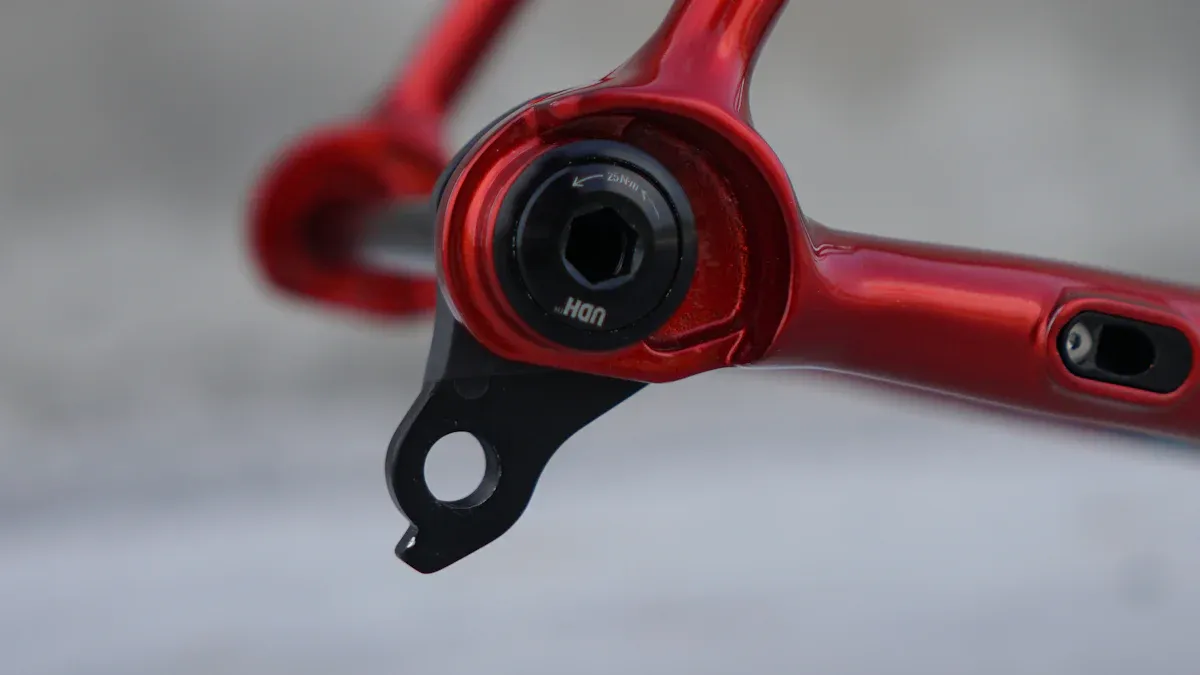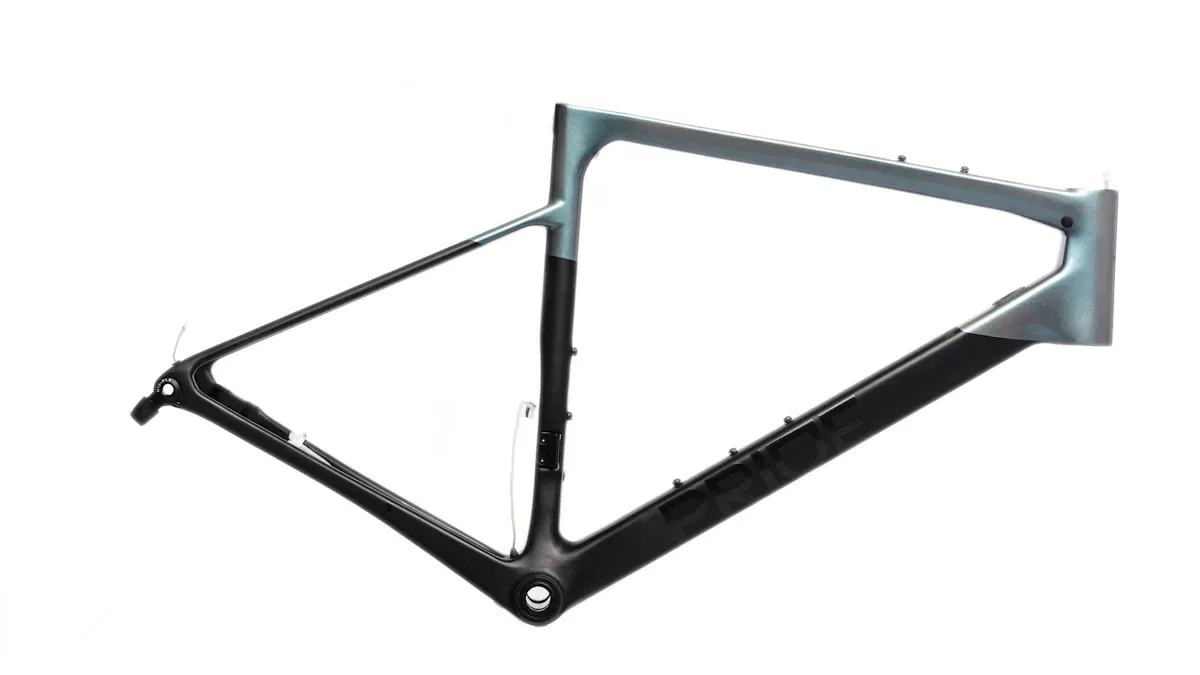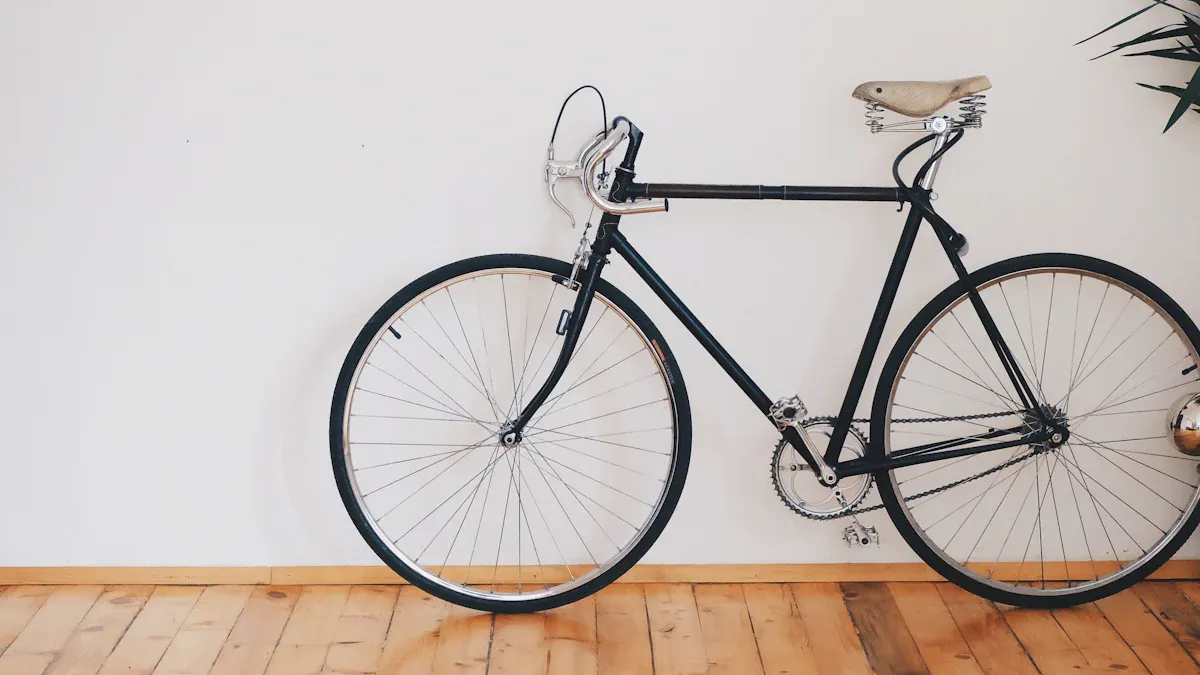
Choosing the right standard bike frame is very important. It helps you feel comfortable and perform well on the road or trail. A good standard bike frame makes your ride better. It can also stop you from feeling pain on long rides. Research shows that a proper bike fit lowers the chance of injuries. These injuries can include knee and back pain. When picking a standard bike frame, think about your body size and how you ride. This personal method makes sure you have a comfy ride and stay safe while riding.
Key Takeaways
Pick a bike frame that fits your riding style. This will help you feel more comfortable and perform better.
Measure your inseam and height carefully. This helps you find the right bike size and avoid discomfort.
Try riding different bikes. This lets you see how they feel and make changes for a better fit.
Look at bike size charts. You can also think about getting a professional fitting to make your ride better.
Choosing the right bike frame helps you ride safely. It also makes cycling more enjoyable and comfortable.
Riding Style
Your riding style is very important when picking a bike frame. Different styles like BMX racing, mountain biking, or commuting need special frame features. These features help with comfort and performance. Knowing these styles helps you choose the right frame shape.
Types of Riding
BMX Racing: This style needs a light frame. It should have a shorter chainstay for fast starts. A steeper head tube angle (around 74.5°–75.5°) helps with quick steering for tight turns.
Mountain Biking: Riders want a slacker head tube angle (72°–73°) for stability on hills. Longer chainstays (13.6″–13.9″) help with balance at high speeds. A higher bottom bracket height makes cornering easier.
Commuting: Comfort is very important here. Step-through frames make it easy to get on and off. They are great for city riding. Good grips and soft saddles make the ride better.
Frame Characteristics
It is important to match frame features to your riding style. For example, racing bikes have a steeper seat tube angle. This helps position your hips over the pedals for more power. Endurance bikes have a relaxed shape for comfort on long rides.
The table below shows how different bike shapes fit various riding styles:
Geometry Aspect | Racing Bikes | Mountain/Adventure/Commuting Bikes | Impact on Riding Style and Handling |
|---|---|---|---|
Head Tube Angle | Steeper (e.g., ~72°) | Slacker (e.g., ~65°-70.5°) | Steeper angles allow quicker steering; slacker angles improve stability on rough terrain. |
Seat Tube Angle | Steeper (e.g., 74°) | Slacker (e.g., 72°-73°) | Steeper angles help with climbing; slacker angles are better for comfort on flat rides. |
Reach | Longer (e.g., 390 mm) | Shorter (e.g., 375 mm) | Longer reach helps with an aerodynamic position for racing; shorter reach supports a comfortable posture. |
Stack | Lower (e.g., 575 mm) | Higher (e.g., 595 mm) | Lower stack helps with an aggressive position; higher stack offers a relaxed riding position. |
Chainstay Length | Shorter (e.g., 425 mm) | Longer (e.g., 440 mm) | Shorter chainstays allow quick acceleration; longer chainstays improve stability. |
Wheelbase | Shorter (e.g., 1025 mm) | Longer (e.g., 1048 mm) | Shorter wheelbase gives quicker handling; longer wheelbase increases stability at speed. |
These shape choices show how different riding styles need different bike frames. By knowing your riding style, you can choose a frame that helps you ride better and feel more comfortable.
Standard Bike Frame Types

When you pick a bike, knowing the different bike types is very important. Each type has special features for different riding needs. Here, we will look at three popular bike types: road bikes, mountain bikes, and hybrid bikes.
Road Bikes
Road bikes are made for speed on smooth roads. They have light frames and thin tires, which help them roll easily. The shape of a road bike usually has a longer reach and a lower stack height. This design helps you get into a position that makes you go faster. Most road bikes are made from aluminum or carbon fiber. These materials are strong but light.
Comfort Factors | Performance Factors | |
|---|---|---|
Aluminum | Moderate comfort; lighter than steel | Light and resists rust; good for racing |
Carbon Fiber | Custom comfort; smooth ride | Very strong for its weight; great for performance |
Mountain Bikes
Mountain bikes are made for rough trails. They have wider tires and stronger frames to handle bumps and obstacles. The shape of mountain bikes often has a slacker head tube angle for better balance on hills. Common materials for mountain bike frames are steel, aluminum, and carbon fiber. Each material has its own benefits:
Material | Common Use in Mountain Bikes | Key Properties and Reasons for Use |
|---|---|---|
Steel | Frames and fork blades | Strong and tough; absorbs shocks well but is heavier. |
Aluminum Alloys | Frames | Light and stiff; popular because they are strong for their weight. |
Carbon Fiber | High-end frames | Light and can be changed; allows for special ride features. |
Hybrid Bikes
Hybrid bikes mix features from both road and mountain bikes. This makes them good for many riding places. They usually have a more upright position, which is comfy for casual riders and city commuters. Hybrid bikes often have medium-width tires that balance speed and grip.
They have flat handlebars for better control.
Some hybrids have basic front suspension to handle small bumps.
Gearing options work for both flat and hilly areas.
This mix lets hybrid bikes do well on city streets, paved roads, park trails, and light gravel paths.
Knowing these standard bike frame types helps you choose wisely based on your riding style and likes. Each bike type has its own benefits, so think about what works best for you.
Key Measurements for Bike Sizing Guide
When you choose the right bike frame, getting the right measurements is very important. You should think about your inseam, height, and standover height. These measurements help you find a bike that fits well and makes riding more enjoyable.
Inseam Measurement
To measure your inseam, do these steps:
Put a hard object, like a book, between your legs, pressing it against your body.
Measure from the top of the book down to the floor. This is your inseam length.
Your inseam is a key factor in finding the right bike frame size. For road bikes, multiply your inseam length by 0.67 to get the frame size in centimeters. For mountain bikes, make sure you have 1-2 inches of space between your inseam and the bike’s top tube. This space is important for comfort and safety.
Remember, measuring your inseam correctly helps avoid sizing errors. It ensures comfort, safety, and good pedaling.
Height Measurement
Measuring your height is easy. Here’s how to do it right:
Stand straight against a wall without shoes.
Mark the top of your head on the wall.
Measure from the floor to the mark to find your height.
Your height helps you find the right bike frame size. But it’s not the only thing to think about. You should also look at your inseam and arm span. These measurements work together to give you a complete fit picture.
Standover Height
Standover height is the space from the ground to the top of the bike’s top tube. It is very important for safety, comfort, and performance. You should have at least 1-2 inches of space between your inseam and the top tube for road and hybrid bikes. For mountain bikes, aim for 2-3 inches of space.
Having the right standover height helps you get on and off the bike safely. It also lets you place your feet quickly during stops, helping you keep your balance in emergencies. Not having enough space can cause painful contact with the top tube, which can lead to injury.
Rider Comfort | Safety Level | Performance Impact | |
|---|---|---|---|
1-2 inches (ideal) | High | High | Best control |
Less than 1 inch | Moderate | Moderate risk | Possible discomfort |
No clearance or tight fit | Low | High risk injury | Less maneuverability |
Having the right standover height boosts your confidence and safety while riding. It helps you sit up straight, reducing strain and tiredness.
Choosing the Right Bike Size

Picking the right bike size is very important for your comfort and how well you ride. You can use bike size charts to help you decide. These charts can be different for each brand and bike type, so it’s important to know how to read them.
Size Charts
When you look at the bike size chart, pay attention to these main points:
Seat Tube Length: This is the most important measurement for sizing. It relates to your leg inseam.
Top Tube Length: This affects how far you reach and your posture while riding.
Standover Clearance: Aim for 1-2 inches for road bikes and 2-3 inches for mountain bikes.
Different bike types need different sizes. For example, mountain bikes often use sizes like XS, S, M, L, and XL, while road bikes usually use centimeters.
Remember, wheel size is not a good way to size a bike. Instead, focus on your inseam and height. Comparing these measurements to the frame size helps you get a better fit.
If you are between sizes, think about your riding style. Choose a bigger size for stability and efficiency on road bikes. Choose a smaller size for better control on mountain bikes.
Expert Consultation
Talking to an expert can really help you pick the right bike frame. Professional fitters use special methods to check your body mechanics. They look at your flexibility, mobility, and riding goals. This personal approach helps you avoid common mistakes, like only using standard sizing methods.
Professional fitting is more than just picking a size. It improves your riding position, making it more comfortable and better for performance. While online calculators can help, they are not as accurate as an in-person fit.
Getting a professional bike fit is a smart choice, especially for new riders. It helps you choose the right bike size and frame shape that fits your needs.
By following these tips and checking the bike size chart, you can confidently pick the right bike size. This choice will make your riding experience better and help you avoid pain or injury.
Perfect Fit Through Test Riding
Test riding a bike is very important for finding the right fit. It helps you check comfort and performance before buying. During a test ride, pay attention to how the bike feels and if it matches your riding style. Here are some tips to make your test ride better:
Test Riding Tips
Test multiple frame sizes: Try different sizes to see which fits your body best.
Focus on comfort: Notice your body position and how it feels while riding.
Ride on various terrains: Test the bike on different surfaces you might ride on, like pavement, gravel, or hills.
Consider professional fitting services: If you have special fit needs or feel unsure, ask a professional for help.
Key frame geometry factors to check include top tube length, head tube length, reach, and stack. These measurements affect your riding position and comfort. For example, head tube length changes handlebar height, while top tube length affects your reach and upper body position.
Adjustments for Comfort
After test riding, you might need to make changes for better comfort. Here are some common adjustments:
Saddle height: Changing the saddle height can greatly affect your pedaling. A saddle too low can hurt your knees, while one too high can make your hips rock.
Saddle position: The horizontal saddle position impacts your posture. Use the KOPS (knee over pedal spindle) method to start adjusting.
Handlebar height and reach: Changing the handlebars can help your comfort. Make sure they are easy to reach with a slight bend in your elbows to avoid overstretching.
Bike shops often let you test ride bikes that can be fully adjusted. Experts watch and change key contact points, like saddle position and handlebar height, to improve comfort and speed. This process can take 1.5 to 2 hours and may include follow-up sessions to ensure you stay comfortable after real-world riding.
By taking time to test ride the bike and make needed adjustments, you can find a perfect fit that makes your riding experience better.
Choosing the right bike frame is very important for your comfort and how well you ride. Keep these main points in mind:
Know your riding style and how it affects your frame choice.
Measure your inseam and height to find the best fit.
Test ride different bikes to check comfort and make changes if needed.
Spending time to pick the right bike frame size gives you long-term benefits. It makes riding more comfortable, helps you ride better, and lowers the chance of getting hurt. Cycling experts say that choosing the right frame affects how much you enjoy riding.
If you need help, look at sizing charts or ask for professional fitting services. Enjoy the process of finding your perfect bike! 🚴♂️
FAQ
What is the best way to measure my inseam?
To measure your inseam, stand barefoot against a wall. Place a book between your legs, pressing it against your body. Measure from the top of the book to the floor. This measurement helps you choose the right bike size.
How do I choose the right bike size?
You can choose the right bike size by consulting the bike size chart. Compare your inseam and height measurements to the chart. This process ensures a comfortable riding experience and helps you avoid discomfort during rides.
Why is test riding important?
Test riding the bike allows you to assess comfort and fit. You can feel how the bike handles and whether it suits your riding style. This step is crucial for ensuring a perfect fit before making a purchase.
What factors should I consider when selecting a bike type?
When selecting a bike type, consider your riding style, terrain, and comfort preferences. Different bike types, like road, mountain, or hybrid, offer unique features that cater to specific riding needs. Choose one that aligns with your goals.
How can I ensure a safe riding experience?
To ensure a safe riding experience, measure your inseam and height accurately. Test ride the bike to check for comfort and fit. Adjust the saddle and handlebars as needed to achieve a perfect fit that enhances control.
See Also
Selecting The Ideal Bike Frame To Suit Your Needs
Key Factors To Find The Perfect Bike Frame Fit
Expert Advice On Picking Durable Cargo Bike Frames
